
NUCLEAR POWER PLANTS
.pdfCross-Flow-Induced-Vibrations in Heat Exchanger Tube Bundles: A Review |
125 |
Oengoren, A., Ziada, S., 1995, "Vortex shedding, acoustic resonance and turbulent buffeting in normal triangle tube arrays" Proceedings of FIV-95, 6th International Conference on Flow-Induced Vibration, ISBN 90 5410 547x, ed, Bearman, P. W., pp. 295-313.
Ojalvo, I.U., and Newman, M., 1964, "Natural frequencies of clamped ring segments", Machine Design, pp. 219-222.
Owen P. R., 1965, "Buffeting excitation of boiler tube vibration", Journal of Mechanical Energy Science, Vol. 4, pp. 431-439.
Paidoussis, M. P. 2006, “Real-Life Experiences With Flow-Induced Vibration,” Journal of Fluids and Structures, 22,741 – 755.
Paidoussis, M. P., 1965, "The amplitude of fluid induced vibration of cylinders in axial flow", AECL-2225.
Paidoussis, M. P., 1980, "Flow-induced vibrations in nuclear reactors and heat exchangers: Practical experiences and state of knowledge". In Practical Experiences with FlowInduced Vibrations (eds E. Naudascher and D. Rockwell), Berlin: Springer-Verlag, pp. 1-81.
Paidoussis, M. P., 1981, "Fluid-elastic vibration of cylinder arrays in axial and cross-flow: State of the art", Journal of Sound and Vibration, Vol. 76, pp. 329-360.
Paidoussis, M. P., 1982, "A review of flow-induced vibrations in reactors and reactor components", Nuclear Engineering and Design, Vol. 74, pp. 36-40.
Paidoussis, M. P., 1987, "A review of flow-induced vibrations in reactors and reactor components", Nuclear Engineering and Design, Vol. 74, pp. 31-60.
Paidoussis, M. P., 1987, "Flow-induced instabilities of cylindrical structures", Applied Mechanics Reviews, Vol. 40, pp. 163-175.
Paidoussis, M. P., and Li, G. X., 1992, "Cross-flow-induced chaotic vibrations of heat exchanger tubes impacting on loose supports", Journal of Sound and Vibration, Vol. 152 (2), pp. 305-326.
Paidoussis, M. P., Mavriplis, D., and Price, S. J., 1984, "A potential-flow theory for the dynamics of cylinder arrays in cross-flow", Journal of Fluid Mechanics, Vol. 146, pp. 227-252.
Papp, L., 1988, "Vibration of VVER NPP steam generator tubes," (in Czech), Jadera Energie, Vol. 34, No. 7, pp.249-259.
Papp, L., and Chen, S. S., 1994, "Turbulence-induced vibration of tube arrays in two phaseflow", Journal of Pressure Vessel Technology, Vol. 116, pp. 312-316.
Payen, T., Villard, B., and Jalaldeen, S., 1995, "Experimental validation of tube-to-support impact computations in cross-flow", Proceedings of FIV-95, 6th International Conference on Flow-Induced Vibration, ISBN 90 5410 547x, ed., Bearman, P.W, pp.383-292.
Peterka, F., 1995, "Impact Interaction of two-heat exchanger tubes", Proceedings of FIV-95, 6th International Conference on Flow-Induced Vibration, ISBN 90 5410 547x, ed., Bearman, P.W. pp.393-400.
Pettigrew, M. J., & Taylor, C. E. 2003, “Vibration Analysis Of Shell-And-Tube Heat Exchangers: An Overview—Part 2: Vibration Response, Fretting-Wear, Guidelines,” Journal of Fluids and Structures,18,485–500.
Pettigrew, M. J., & Taylor, C. E. 2003, “Vibration Analysis Of Shell-And-Tube Heat Exchangers: An Overview—Part 1: Flow, Damping, Fluidelastic Instability,” Journal of Fluids and Structures, 18, 469–483.
Pettigrew, M. J., and Gorman, D. J., 1973, "Experimental studies on flow-induced vibration to support steam generator design, Part III", Proceedings of International Symposium on Vibration Problems in Industry, AECL-5804.
126 |
Nuclear Power Plants |
Pettigrew, M. J., and Taylor, C. E., 1994, "Two-phase flow-induced vibrations: An overview", Survey Paper, ASME Journal of Pressure Vessel Technology, Vol. 116, pp. 233-253.
Pettigrew, M. J., Goyder, H. G. D., Qiao, Z. L., and Axisa, F., 1986," Damping of multi-span heat exchanger tubes part I and II", Proceedings of Pressure Vessel and Piping Conference, ASME, 104, pp.81-87.
Pettigrew, M. J., Sylvestre, Y., Campagna, A. O., 1978, "Vibration analysis of heat exchanger and steam generator designs", Nuclear Engineering and Design, Vol. 48, pp. 99-115.
Pettigrew, M. J., Taylor, C. E., & Kim, B.S., 1989, "Vibration of tube bundles in two-phase crossflow: part I: Hydrodynamic mass and damping", ASME Journal of Pressure Vessel Technology, Vol. 111, pp. 466-477.
Pettigrew, M. J., Taylor, C. E., and Kim, B. S., 2000, "The effects of tube bundle geometry on vibration in two-phase cross-flow", Proceedings of the Int. Conf. on FlowInduced Vibrations, FIV-2000, Lucerne, Switzerland, June 19-22, ISBN 90 5809 129 5, pp. 561-568.
Pettigrew, M. J., Taylor, C. E., and Yasuo, A., 1994, "Vibration damping of heat exchanger tube bundles in two-phase flow", Welding Research Council, Bulletin No. 389, New York, pp. 1-41.
Pettigrew, M. J., Taylor, C. E., Jong, J. H., Currie, I. G., 1995, "Vibration of tube bundles in twophase freon cross-flow", Journal of Pressure Vessel Technology, Vol. 117, pp. 321-329.
Pettigrew, M. J., Tromp, J. H., and Mastorakos, J., 1985, "Vibration of tube bundles subjected to two-phase cross-flow", ASME Journal of Pressure Vessel Technology, Vol. 107, p. 335.
Pettigrew, M. J., Tromp, J. H., Taylor, C. E., and Kim, B.S., 1989, "Vibration of tube bundles in two-phase cross-flow, Part II, Fluid-Elastic Instability", Journal of Pressure Vessel Technology, Vol. 111, pp.478-487.
Pettigrew, M.J., Carlucci, L.N., Taylor, C.E., Fisher, N.J., 1991, "Flow-induced vibration and related technologies in nuclear components", Nuclear Engineering and Design, Vol. 131, pp.81-100.
Planchard, J., and Thomas, B., 1993, "On the dynamical stability of cylinders placed in crossflow", Journal of Fluids and Structures, Vol. 7, pp. 321-339.
Prasad, G. V. D., Pandey, M., & Kalra, M. S. 2007, “Review Of Research On Flow Instabilities In Natural Circulation Boiling Systems,” Progress in Nuclear Energy, 49, 429-451.
Price, S. J., 1995, "A review of theoretical models for fluid-elastic instability of cylinder arrays in cross-flow", Journal of Fluids and Structures, Vol. 9, pp. 463-518.
Quinn, E. P., 1962, "Vibration of fuel rods in parallel flow", GEAP-4059.
Rao, M. S. M., Steininger, D. A., and Eisinger, F. L., 1988, "Numerical simulation of fluid-elastic vibration and wear of multi-span tubes with clearance at supports", ASME Proceedings of 2nd International Symposium on Flow-Induced Vibration and Noise, Vol. 5, eds., Paidoussis, M. J. et. al.
Remy, F.N., 1982, "Flow-induced vibration of tube bundles in two-phase cross-flow", Proceedings 3rd Keswick International Conference on Vibration in Nuclear Plant, Paper 1.9, p. 135
Ribot, S. P., & Blanchet, Y. 2007, “Bu eting lift forces and local air–water flow aspects around a rigid cylinder,” International Journal of Multiphase Flow, 33, 1237–1254.
Roberts, B. W., 1962, "Low frequency, Self-excited vibration in a row of circular cylinders mounted in an air-stream", Ph.D Thesis, University of Cambridge.
Roberts, B. W., 1966, "Low frequency, aero-elastic vibrations in a cascade of circular cylinders", I. Mech. E. Mechanical Engineering Science Monograph, No. 4.
Cross-Flow-Induced-Vibrations in Heat Exchanger Tube Bundles: A Review |
127 |
Rogers, R. J., Taylor, C. E., and Pettigrew, M. J., 1984, "Fluid effects on multi-span heat exchanger tube vibration", ASME Journal of Pressure Vessel and Piping, ASME Publication H00316, Topics in Fluid Structure Interaction, pp. 17-26.
Rubiolo, P. R. 2006, “Probabilistic prediction of fretting-wear damage of nuclear fuel rods,” Nuclear Engineering and Design, 236, 1628–1640.
Rubiolo, P. R., & Young, M. Y. 2009, “On the factors affecting the fretting-wear risk of PWR fuel assemblies,” Nuclear Engineering and Design, 239, 68-79.
Schrage, D., 1988, "Two-phase pressure drop in vertical cross-flow across horizontal tube bundle", AIChE Journal, Vol. 34, No.1, pp. 107-115.
Shin, Y. S., and Wambsganss, M.W., 1975, "Flow-induced vibrations in LMFBR steam generators: A state-of-the-art review", ANL-75-16, Report for the U.S. Energy Research, and Development Administration, Argonne National Laboratory, Argonne, Illinois.
Sim, W. G., & Park, M. Y. 2010, “Fluid-elastic Instability of Normal Square Tube Bundles in Two-Phase Cross Flow,” Proceedings of the 18th International Conference on Nuclear Engineering, May 1721, Xi’an, China.
Simpson, F. J., and Hartlen R. T., 1974, "Wind tunnel determination of fluid-elastic vibration thresholds for typical heat exchanger tube patterns", Ontario Hydro Research Division Report, 74-309-K.
Sipvack, H. M., 1946, "Vortex frequency and flow pattern in the wake of two parallel cylinders at varied spacing normal to an air stream", Journal of the Aeronautical Sciences, pp. 289-301.
Smith, S., 1968, "Void fractions in two-phase flow: A correlation based upon an equal velocity head model," Proc. Inst. Mech. Eng.
Standards of Tubular Exchanger Manufacturers Associate 1988, 7th ed., TEMA, New York. Standards of Tubular Exchanger Manufacturers Association, 1978, 6th ed., TEMA, New York. Stokes, G. G., 1843, "On some cases of fluid motion", Proceedings, Cambridge Philosophical
Society, Vol. 8, pp. 105-137.
Taitel, Y., Barnea D., and Dukler, A., 1980, "Modeling flow pattern transition for steady upward gas-liquid flow in vertical tubes", Al ChE Jl., Vol. 26, pp. 345-354.
Tanaka, H., & Takahara, S., 1980, "Unsteady fluid dynamic force on tube bundle and its dynamic effect on vibration", In Flow-Induced Vibration of Power Plant Components, (ed M. K. Au-Yang), PVP-Vol. 41, New York: ASME, pp. 77-92.
Tanaka, H., & Takahara, S., 1981, "Fluid-elastic vibration of tube array in cross-flow", Journal of Sound and Vibration, Vol. 77, pp. 19-37.
Taylor, C. E., 1992, "Random excitation forces in tube arrays subjected to two-phase crossflow", Proceedings of WAM-1992, International Symposium on Flow-Induced Vibration and Noise, Vol. 1, HTDVol. 230, pp. 89-107.
Taylor, C. E., and Pettigrew, M. J., 2000, "Effect of flow-regime and void fraction on tube bundles vibration", Proceedings of FIV-2000, Lucrene, Switzerland, June 19-21, ISBN 90 5809 1295, pp. 529-536.
Taylor, C. E., Boucher, K. M., and Yetisir, M., 1995, "Vibrational impact forces due to twophase cross-flow in u-bend of nuclear steam generators", Proceedings of FIV-95, 6th International Conference on Flow-Induced Vibration, ISBN 90 5410 547x, pp. 401-411.
Taylor, C. E., Currie, I. G., Pettigrew, M.J. and Kim, B. S., 1989, "Vibration of tube bundles in two-phase cross-flow, Part 3: Turbulent Induced Excitation", ASME Journal of Pressure Vessel Technology, Vol. 111, pp.488-500.
Taylor, C. E., Pettigrew, M. J., Dickinson, T. J., Currie, I.G., and Vidalou, P., 1998, "Vibration damping in multi-span heat exchanger tubes", ASME Journal of Pressure Vessel Technology, Vol. 120, pp. 283-289.

128 Nuclear Power Plants
TEMA Standards, 8th edition, Flow-Induced Vibration Program, Version 1.10, Tubular Exchangers Manufacturers Association Inc
Thomas, D. G., and Kraus, K. A., 1964, "Interaction of vortex streets", Journal of Applied Physics, Vol. 35, p. 3458-3459.
Thorngren, J. T., 1970, "Predict heat exchanger tube damage", Hydro Carbon process, Vol. 49 (4), pp. 129-131.
Timoshenko, G. P., 1955, "Vibration Problems in Engineering", 3rd edition, D. Van Nortrand Co., Inc, Princeton, N.J., pp. 324-342.
Ulbrich, R., Mewes, D., 1994, "Vertical, upward gas liquid two-phase flow across a tube bundle", International Journal of Multiphase Flow, Vol. 20, pp. 249-272.
Ulbrich, R. N., & Mewes, D., 1997, "Recognition of flow pattern for two-phase flow across tube bundle", 4th World Conference on Experimental Heat Transfer, Fluid Mechanics and Thermodynamics, Brussels, June 2-6.
Vander Hoogt, P. J. M., and Van Campen, D. H., 1984, "Self-induced instabilities of parallel tubes in potential cross-flow", In Proceedings ASME Symposium on Flow-induced Vibrations, Vol. 2: Vibration of Arrays of Cylinders in Cross Flow (eds. M. P. Paidoussis, M. K., Au-Yang and S. S., Chen), New York: ASME, pp. 53-66.
Wambsganss, M. W., Jendrzejczyk, J. A., and France, D. M., 1992, "Two-phase flow and pressure drop in flow passages of compact heat exchangers", SAE Technical Paper Series 920550.
Wambsganss, M. W., Chen, S.S., and Jendrzejcyk, J.A., 1974, "Added mass and damping of a vibrating rod in confined viscous fluid" ANL-CT-75-08, Report, Argonne National Laboratory, Argonne, Illinois.
Wang, Y. Q., Jackson, P., & Phaneuf, T. J. 2006, “Turbulent Flow Through a Staggered Tube Bank,” Journal Of Thermophysics And Heat Transfer, Vol. 20, No. 4.
Weaver, D. S. and J.A. FitzPatrick, 1988, "A review of cross-flow-induced vibrations in heat exchanger tube arrays", Journal of Fluids and Structures, Vol. 2, pp. 73-93.
Weaver, D. S., 1993, "Vortex shedding and acoustic resonance in heat exchanger tube arrays", Technology for the 90's, ASME Special Publication, New York, pp. 776-810.
Weaver, D. S., and Fitzpatrick, J. A., 1988, "A review of flow-induced vibrations in heat exchangers", Journal of Fluids and Structures, Vol. 2, pp. 73-93.
Weaver, D. S, 1993, “An introduction to flow-induced vibrations “lecture notes, BHRA”, The Fluid Engineering Center, Cranfield, Bedford, England.
Williamson, C. H. K., & Govardhan, R. 2008, “A Brief Review Of Recent Results In VortexInduced Vibrations,” Journal of Wind Engineering and Industrial Aerodynamics, 96, 713 – 735.
Zaida, S., Oengoren, A., and Buhlmann, E. T., On acoustical resonance in tube arrays Part-I: Experiments", International Symposium on Flow-induced Vibrations and Noise, Vol. 3, Winter Annual Meeting, Chicago, IL, ASME, pp. 219-243.
Zhou, T., and Rogers, R. J., 1997, "Simulation of two-dimensional squeeze film and solid contact forces acting on a heat exchanger tube", Journal of Sound and Vibration, Vol. 203(4), pp. 621-639.
Ziada, S., and Oengoren, A., 1992, "Acoustic and mechanical resonances in tube bundles" Report No. SAK- TB92-063, Sulzer Innotec Limited Winterthur, Switzerland.
Zuber, N., Findlay, J., 1965, "Average volumetric concentration in two-phase flow systems", Journal of Heat Transfer, pp. 453-468.
Zukauskas, A., Ulinskas, R. and Katinas, V. 1987, "Fluid dynamics and flow-induced vibrations of tube banks", New York: Hemisphere Publishing.
5
The Gap Measurement Technology and Advanced RVI Installation Method for Construction Period Reduction of a PWR
Do-Young Ko
Central Research Institute, Korea Hydro & Nuclear Power Co., Ltd.
Republic of Korea
1. Introduction
A nuclear power plant takes approximately 52–58 months from the first concrete construction until the completion of the performance test. Many research groups throughout the world have studied ways to shorten the construction period of nuclear power plants to 50 months. Therefore, the construction period of a nuclear power plant is one of the most important factors to make a company competitive in international nuclear energy markets. There are many advanced construction methods to decrease the construction period for new nuclear power plants. This chapter is related to the modularization of reactor vessel internals (RVI) that one of the most effective methods to reduce the construction period of nuclear power plants (Ko et al., 2009) (Ko & Lee, 2010) (Ko, 2011) (Korea Hydro & Nuclear Power Co., Ltd., 2009).
2. Development of reduced-scale model system for measurement system
Generally, the RVI comprise three components: the core support barrel (CSB), the lower support structure (LSS)/core shroud (CS), and the upper guide structure (UGS). The existing method of assembly is very complicated and requires approximately 8 - 10 months to complete (Korea Electric Power Research Institute, 1997) (Korea Hydro & Nuclear Power Co., Ltd., 2002). The installation of the reactor vessel (RV) is a critical process during the construction period.
This part describes the RVI installation method using the RVI modularization which can shorten the construction period by a minimum of two months compared to the existing method. In order to modularize the RVI, gaps between the CSB snubber lug and RV corestabilizing lug must be measured using a remote method at outside the RV. Therefore, this part includes explanation on a measuring system to measure gaps between the RV and the CSB remotely with the aim of RVI modularization. The remote measurement system was developed for use at actual construction sites of nuclear power plants using a measurement sensor, a threaded connection jig, and a zero-point adjustment device. With these, a reduced-scale model system was validated. With the remote measurement system, experiments and analyses were performed using mockups for both the RV and the CSB to
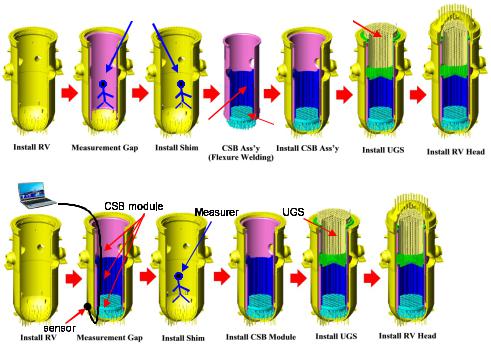
130 |
Nuclear Power Plants |
verify the applicability of the described system in a construction project. From the data acquired by the remote measurement system, shims were separately made and adjusted.
After installing the shims on RV core-stabilizing lugs, the gaps satisfied requirements within the permissible range of 0.381 – 0.508 mm. The reliability and applicability of the remote measurement method were evaluated and it was concluded that the remote measurement system enables RVI modularization with a significantly reduced construction period.
Fig. 1 shows an existing nuclear reactor installation method and the developed modularization method by remote gap measurement.
RVI is classified on a large scale into three categories: CSB, LSS/CS and UGS. When a nuclear power plant is built, the materials are delivered and assembled according to which category they fall under. It is, however, possible to modularize the installation of the CSB and LSS/CS (Ko et al., 2009) ( ABB-CE, 1995).
Gaps between CSB snubber lug and RV core-stabilizing lug can be measured at outside the RV by a remote method in order to modularize the RVI. If the CSB module (CSB and LSS/CS) is installed into RV, access to measuring the gaps is cut off by the LSS/CS. Therefore, the gaps must be measured remotely at outside the RV.
Fig. 2 shows a picture of the second step in Fig. 1(a)
Measurer |
UGS |
CSB
LSS CS
a) Existing nuclear reactor installation method
(b) Proposed modularization method
Fig. 1. Existing method and developed modularization method by gap measurement remotely
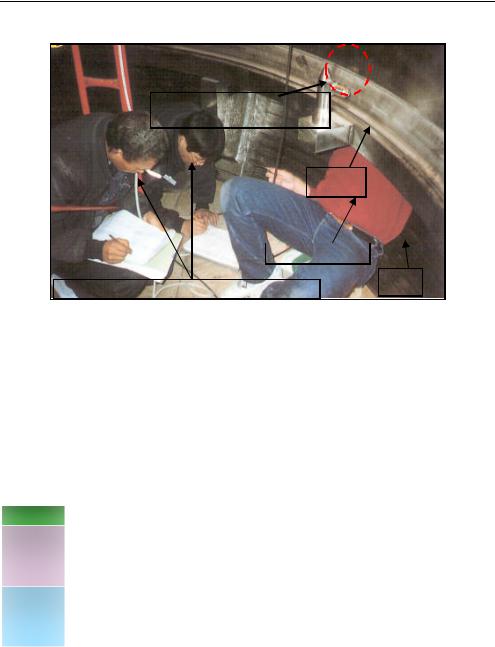
The Gap Measurement Technology and Advanced RVI |
131 |
Installation Method for Construction Period Reduction of a PWR |
Gaps between CSB and RV
CSB
Hand-measurer
RV
Hand-measurement values recorders
Fig. 2. Picture of the second step in Fig. 1 (a), showing manual gap measurement.
The hand-measurement of Fig. 2 takes a lot of measurement times and it occurs measurement errors by measurers. Also, a measurement space is small and narrow, and environment to measure gaps between RV and CSB is uncomfortable.
Fig. 3 shows timescales of existing installation method and developed method.
As shown in Fig. 3, developed modularization method by gap measurement remotely can reduce the critical path of the construction period by approximately 8-12 weeks. If the construction period is reduced, a construction budget expected to be saved the minimum $ 176 million in Korea.
Months |
1 |
|
2 |
3 |
4 |
|
|
5 |
|
6 |
|
|
7 |
|
|
8 |
|
9 |
||||
Existing |
|
Install RV |
|
|
|
Install Shim |
|
|
Install CSB Ass’y |
|
Install RV Head |
|||||||||||
method |
|
|
|
|
|
|
|
|
|
|
|
|
|
|
|
|
|
|
|
|
|
|
|
70 |
|
34 |
|
|
35 |
|
|
48 |
|
|
12 |
25 |
|
|
14 |
|
|||||
(ex. Uljin #5, |
|
|
|
Measurement Gap |
|
|
|
|
CSB Ass’y |
|
Install UGS |
|
|
|||||||||
Korea) |
|
|
|
|
|
|
|
|
|
|
(Flexure Welding) |
|
|
|
|
|
|
|
||||
|
|
|
|
|
|
|
|
|
|
|
|
|
|
|
|
|
|
|
|
|
|
|
|
|
|
|
|
|
|
|
|
|
|
|
|
|
|
|
|
|
|
|
|
|
|
|
|
|
|
|
|
34 |
|
|
|
25 |
|
|
|
|
|
|
|
|
|
|
|
|
Proposed |
|
Install RV |
|
|
Install Shim |
|
|
Install UGS |
|
|
|
|
|
|
|
|||||||
modularization |
|
70 |
|
21 |
26 |
12 |
25 |
|
14 |
|
|
|
|
|
|
|
|
|
||||
method |
|
|
|
Measurement Gap Install CSB Module |
48Install RV Head |
|
|
|
|
|
|
|
||||||||||
|
|
|
|
|
|
|
|
|
|
|
|
|
|
|
|
|
|
|
|
|
|
|
Fig. 3. Timescales of existing installation method and proposed method
Fig. 4 shows a section of the RV core-stabilizing lug and the CSB snubber lug that shall be measured remotely for the modularization of the RVI.
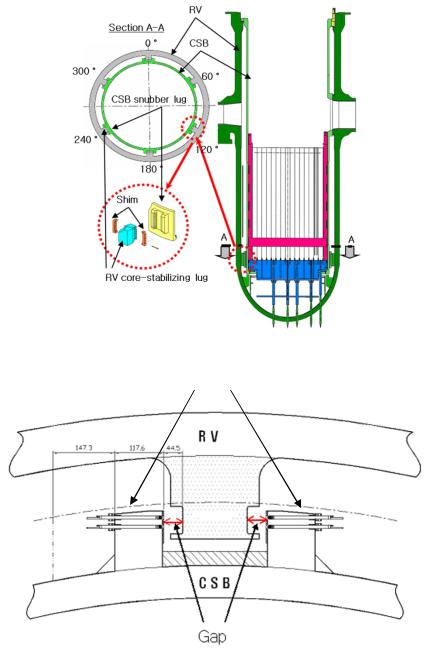
132 |
Nuclear Power Plants |
(a) Measurement parts between RV core-stabilizing lug and CSB snubber lug
Measurement sensor
(b) Gaps between an RV core-stabilizing lug and a CSB snubber lug
Fig. 4. Measurement parts and gaps between the RV Core-stabilizing lug and the CSB snubber lug
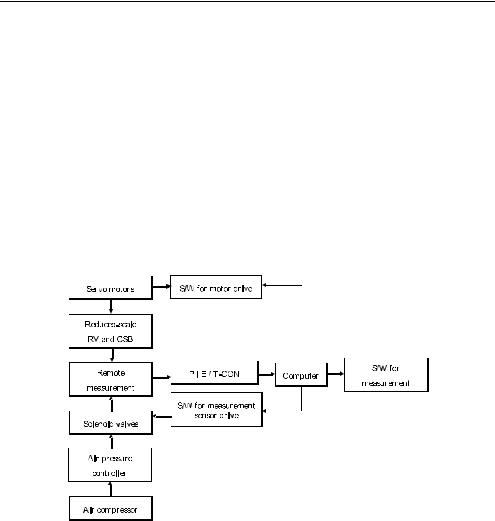
The Gap Measurement Technology and Advanced RVI |
133 |
Installation Method for Construction Period Reduction of a PWR |
2.1 Design of a reduced-scale model system for the physical simulation of gap measurement
2.1.1 Design
The purpose of designing a reduced-scale model system for the modularization of the reactor internals is to confirm the performance and application conditions of a remote distance measurement sensor selected. The sensor should be able to measure gaps between the CSB snubber lug and the RV core-stabilizing lug in the range 0.381–0.508 [mm].
This system was designed to be used at narrow space and small probe hole conditions and to be light easy to handle by using aluminum material. A threaded connection jig allows the remote measurement sensor to be assembled into the CSB snubber.
The block diagram in Fig. 5 shows the reduced-scale model system. The servomotors provide the movement in the up/down and front/rear directions for the reduced-scale models of the CSB snubber lug with remote measurement sensors connected. The air compressor drives the measurement sensors and the obtained data are displayed on the computer screen through the interface modules and network cables.
Fig. 5. Block diagram of reduced-scale model system
2.1.2 Fabrication
The picture in Fig. 6 shows the reduced-scale model system that consists of the reducedscale CSB snubber lug , the reduced-scale RV core-stabilizing lug, 4 remote distance measurement sensors, the air supply device, 2 servo motor devices, the data interface modules and a laptop computer.
The components of the reduced-scale model system were fabricated as follows.
-The model pieces of the CSB snubber lug and RV lug were machined to precisely represent the surface and inside of the remote distance measurement sensors’ hole. The material is aluminum alloy.
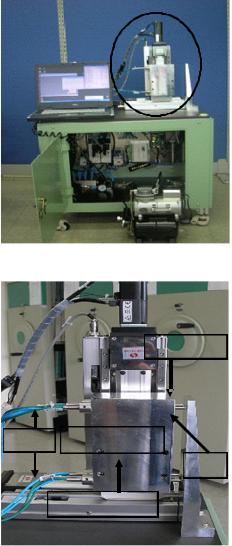
134 |
Nuclear Power Plants |
-The threaded connection jig of the remote distance measurement sensor was fabricated.
-The zero point adjustment device was fabricated.
-The block gauge was used to test the reliability of the remote distance measurement sensors.
(a)
Sensor head
Sensor Reduced-scale RV 
Gap
Reduced-scale CSB
(b)
(a) Overall system, (b) Enlarged circle of Fig. 6 (a) to simulate measurement of gaps between CSB snubber lug and RV core-stabilizing lug
Fig. 6. Reduced-scale model system for the modularization of reactor internals
